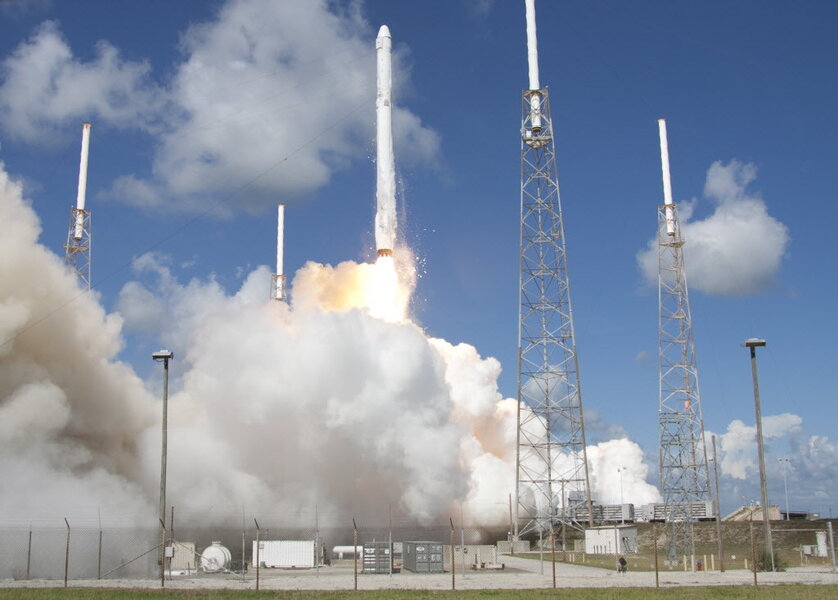SpaceX explosion: What happened?
Loading...
In a press conference on Monday, SpaceX chief executive officer Elon Musk said that a preliminary investigation had shown that a faulty strut caused the June 28th launch failure and explosion of the company’s Falcon 9 rocket and Dragon spacecraft.
A third-party-manufactured steel strut – used to hold down helium vessels within the liquid oxygen tank during flight – broke, causing one of the helium tanks to come free during the second stage of the rocket’s ascent, Mr. Musk said. This caused the tank of liquid oxygen to experience an over-pressurization and rupture, resulting in the launch failure and explosion.
Musk reiterated that this investigation is a preliminary assessment conducted alongside the National Aeronautics and Space Administration, the Federal Aviation Administration, and the US Air Force. The findings given to the press are what they believe is the root cause, but Musk noted that that could change as more information is uncovered.
The problem, he said, is that much was destroyed in the explosion. To further add complexity, only 0.893 seconds passed between the initial sign of failure and the destruction of the spacecraft.
“[It’s] very important to understand the exact sequence of what happened,” says Musk.
The ground team had communication with the spacecraft up until it fell out of the horizon, Musk told reporters. Accelerometer and diagnostic readings continued transmission throughout the disaster, and through a series of follow-up tests, the investigative team concluded that the fault occurred in the rocket’s second-stage liquid oxygen tank.
The liquid oxygen, or LOX, tank is part of the rocket’s fuel tank. In order to keep the liquid oxygen tank correctly pressurized, helium tanks are held within the LOX chamber. These helium tanks release the gas to counteract the depleted liquid oxygen and keep the chamber’s pressure relatively constant. Helium, as an inert gas, can easily fill to re-pressurize the chamber without fear of dangerous side effects.
Or at least that’s how it’s supposed to work.
During the initial ascent of the Falcon 9, one of the many helium tanks became dislodged, firing through the chamber at high speed and releasing helium. The LOX tank became over-pressurized and burst, causing the explosion.
The chamber was tested for these types of things, says Musk. And the amount of G-forces should not have broken any of the materials in-flight. Each individual strut, he said, is built to withstand five times as much pressure as the one that broke.
The fact that one broke goes against the material specifications and the company’s experiences with the product for all previous launches. But after an initial investigation of testing hundreds of struts, SpaceX found that some did break under lower-than-expected pressure margins.
As the rocket ascends, gravitational forces dramatically increase, and so does the buoyancy on the helium tanks. Lighter than liquid oxygen, the helium vessels want to escape their hold and go upward. Each strut must withstand whatever forces are acting on the tank to avoid catastrophe.
It’s important to reiterate how quickly this happened: in less than one second the fuel tank encountered a problem and burst. Blink twice. More time passed there than did during the failure of the rocket. It also likely took you more time to read the words “blink twice” than it did for one of rocket's helium canisters to come loose, project into the side of the LOX tank, over-pressurize the fuel tank, and explode.
Rocket science is hard. There’s a reason it serves as analogy to all other seemingly difficult tasks.
“A passing grade is 100 percent,” Musk noted. If even one thing goes wrong, the entire operation can fail. “From liftoff, it’s 100 percent or nothing.”
Musk said that the SpaceX team will start testing each strut individually before future flights, and will implement software patches into Dragon 1 that will launch a parachute if the rocket encounters an ascent error, allowing the spacecraft to separate from the fuel tank and float safely back down.
While this “abort software” is implemented into Dragon 2, which is designed to transport human crew, it wasn’t loaded into this launch of Dragon. Musk acknowledged that there were ways for the company to constantly improve, and that many changes will take place to ensure that future materials are properly tested.
“To some degree, I think the company as a whole became a little bit complacent,” he says.
For seven years without a failure, he noted that his concerns of launch failure were starting to appear like paranoias to his team. Most of those at the company had never seen something go wrong, and so they might not have been as prepared to check for errors, himself included.
“When you only see success, you don’t fear failure quite as much,” he says.








